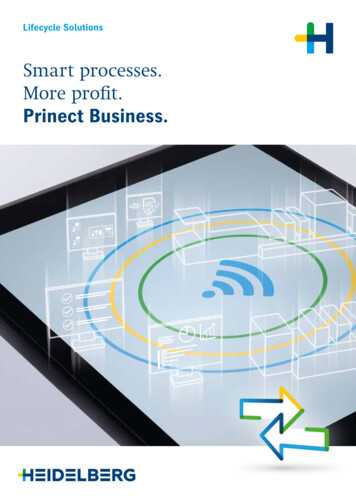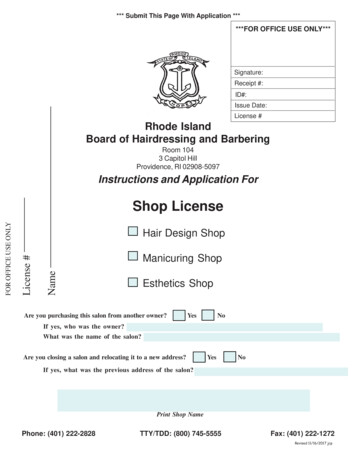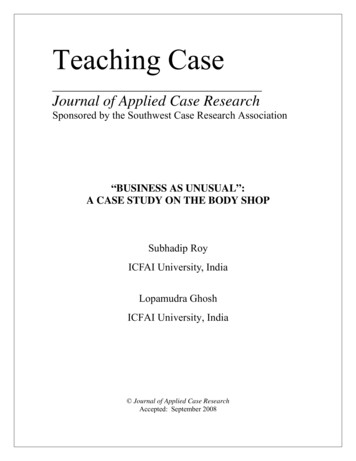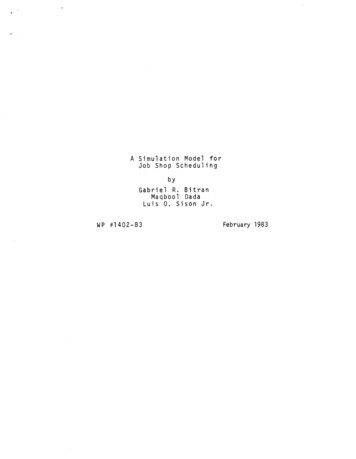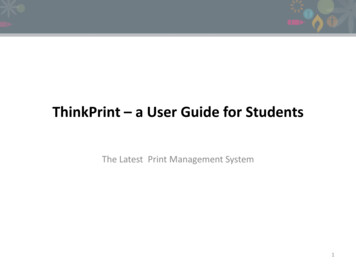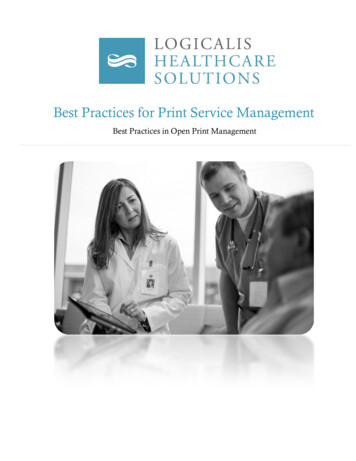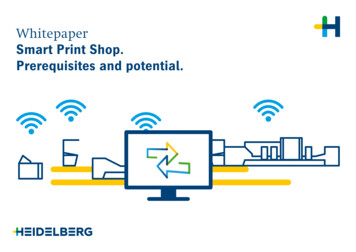
Transcription
WhitepaperSmart Print Shop.Prerequisites and potential.
Driving the Smart Print Shop.Increasing productivity andprofit with smart production.Digitization offers the printing industrymany opportunities. Whoever wants to takeadvantage of these opportunities, however,must actively shape the change. New processes are the key to higher productivity –with consistent digitization and optimizationof print production. With intelligentmachines and processes that process printjobs completely autonomously. The operatoronly has to intervene if necessary. You canfully exploit the potential of your machinesand often double your productivity. Pushto Stop becomes a reality. Your print shopbecomes a smart print shop.››heidelberg.com/en/smartprintshop
ContentsIntroduction 04Influencing factors01 Integrate customers 0602 Reduce touchpoints 0803 Increase productivity andoperating time 1204 Reduce paper waste andwarehousing 1405 Optimize consistency andreproducibility 06 Business Intelligence 1618Prinect 20Prinect Smart BI 21References 223
Whitepaper Smart Print Shop Introduction Push to StopPush to Stop.What characterizes a smart printshop with the Push to Stop standard?There are two key prerequisites:1.A defined structure that describes and standardizes theprocesses. With the goal of reducing touchpoints alongthe workflow, defining rules for controlled productionplanning, and standardizing the handling of substratematerials and consumables. As well as the willingnessto consistently adhere to and repeat these processes.2.On their own, none of theaspects will deliver theexpected improvements.Together, however, theyopen up new potential andbusiness models. The performance of the print shopimproves significantly.An integrated and comprehensive workflow requiredfor the Push to Stop production standard. It raises productivity to a new level and ensures that the right datais always in the right place at the right time.4
Whitepaper Smart Print Shop Influencing factorsInfluencing factorsOperating a smart print shop with thePush to Stop standard calls for newand improved processes. Six key factorswill help to make your print shop moreprofitable.Integrate customersWhat opportunities exist?What do solutions look like?What are the benefits of optimization?We show you the potential.Reduce touchpointsIncrease productivityand operating timeReduce paper waste andwarehousingOptimize consistency andreproducibilityA brief introduction to Prinect . Play the clip!heidelberg.com/en/prinect introBusiness Intelligence››5
Whitepaper Smart Print Shop Influencing factors Integrate customers01. Integrate customersWeb-based portals can be used formore than the direct marketing ofprinted products. In fact, onlineservices offer entirely new opportunities for customer integration.Web portals are changing the workflowsin a print shop. Your customers can viewtheir online and offline orders centrally,manage orders and budgets online, callup prices immediately, and be notifiedabout current promotions online.More scalabilityeCommerce portals enable you to grow inaccordance with market demand. Simplyby opening new sales channels. Depending on customer needs, new market segments can be opened up again and again.The possible applications and services areas varied as the customers. Depending onthe segment and offering, they rangefrom simple shopping with a mouse clickto extensive B2B portals for special customer requirements. Such efficient andcost-effective sales and service platformsoffer print shops a unique opportunityto open up new markets.More efficiencyIntegrated into MIS/ERP and production,eCommerce portals increase efficiency byallowing customers to conveniently placetheir orders online. Your employees areno longer limited to taking orders; theyhave the scope for additional services.The data is not entered manually into different systems repeatedly. Defect susceptibility is reduced, while at the same timeshipping is sped up and throughput isincreased.Portal solutions are online communicationchannels. Created to meet customerrequirements in a way that addresses specific target groups. Automation tools andthe connection to the production processgive you maximum effectiveness. Foryour benefit and the customers’ benefit.In addition, modern printing presses useautomatically provided data to independently configure and start processes.Because manual data entry and job preparation are too cost- and time-intensive tohold their own in the market in the longterm.6
Whitepaper Smart Print Shop Influencing factors More customersVaried product catalogs make eCommerce portals a powerful acquisition tool.Because customers not only prefer theonline channel, they actually expect anddemand it. Print shops and distributorscan use customers’ online searches forthe best prices to pursue new contactsand from this make successful customercontacts.More turnovereCommerce portals work with automatedrecommendations for additional and follow-up sales. They provide individual purchase recommendations and encouragecustomers to purchase related products.More customer serviceChange your customer service. Integratedinto an MIS, eCommerce portals provideindividual account, order, history, andtracking information. In addition, products, services, and prices can be displayed,tailored to the customer’s profile.Integrate customersMore salesThe Sales department also benefits fromthe support of the eCommerce portals.Employees working in the field or at othersites have a customer-specific, currentoverview of orders, pricing, and order history at all times.More brandseCommerce portals allow you design websites according to your specific needs. Thepossibilities are varied: from multi-brandwebsites through microsites for different distributors or special customers tointernational websites with multilingualcontent in different currencies.BenefitsSuccessful integration strengthens the bond with existingcustomers and addresses new customers. Service improvesbecause a direct online response is possible. Content thatcomes directly from the customer makes the Smart Print Shopmore efficient.The result is shorter processing times, lower costs, and fewerdefects in production. Additional and follow-up sales providea way of generating extra turnover.More knowledgeeCommerce portals provide the basis formeaningful analyses. Print shops can easily measure and evaluate the success ofmarketing campaigns or the effectivenessof the Sales department, the product mix,the inventory turnover, and the customerretention. The intelligent data platformsupplies valuable and reliable insightsthat exceed the possibilities of standardanalysis tools.7
Whitepaper Smart Print Shop Influencing factors Reduce touchpoints02. Reduce touchpointsAccording to a study, the areas upstream and downstreamof the printing press are already working near their capacity limit today. In contrast, the pressroom and the CtP areahave considerable spare capacity. This can be exploited byreducing touchpoints.What is a touchpoint?A touchpoint is defined as any intervention by a personthat influences the path of a printed product. Startingfrom the first customer contact through to the product’sdelivery. It makes no difference whether the intervention consists of executing a specific task or making adecision about further production steps, i.e. whether it isrelevant for administration or production. Each touchpoint represents an interruption in the process. Possibleconsequences are defects, loss of time, and higher costs.Reducing touchpoints unlocks previously untappedprofitability. Bottlenecks are eliminated. You can usethe performance of the machines to increase yourproductivity.55 % of the job duration0BILLING AND IMATINGDegree of utilization75JOB ADMINISTRATION100Today, often only25 %of the printing presspotential is exploited.Average job duration: 3 daysSource: Heidelberg Research8
Whitepaper Smart Print Shop Influencing factors Reduce touchpointsA print shop needs fifteen touchpoints onaverage to produce a product:In the Smart Print Shop, the touchpointsare reduced to four 4.15.Estimating Job creation in MIS including job ticket Prepress PDF processing or native artworkImpositionProofing and customer approvalPlate imaging Production planning (capacity, distribution, sustainability, production, materials) Plate sorting and delivery to thepressroomAssignment of ink and paper Press including production dataacquisition Postpress including production dataacquisitionOK sheet approvalQuality controlPackaging and shippingBillingEstimating (end-to-end)PlanningPress and postpress Shipping and billingEach touchpoint is a separate productionstep in the workflow. Further interactionbetween people is necessary to execute it.On average, up to 75 substeps are requiredto exchange all the necessary information.9
Whitepaper Smart Print Shop Influencing factors Reduce touchpoints1st touchpoint2nd touchpoint3rd touchpoint4th touchpointEstimatingEstimating plays a key role in the SmartPrint Shop. Whereas in the past estimating determined the right price for a quotation, its main purpose now is to definethe optimal end-to-end process automation – from customer, prepress, press,and postpress through to shipping.PlanningPlanning is another touchpoint in theintegrated workflow. The tasks involvedare explained in detail in the next section“Reduce paper waste and warehousing”.Press and postpressPress and postpress are a shared touchpoint in the integrated workflow. It ischaracterized by the fast presetting of themachines based on data already definedand entered during the estimating andproduction process. Push to Stop production with autonomous or navigated printing becomes a reality.Shipping and billingShipping is the last touchpoint in theintegrated workflow. It is characterizedby automated shipment tracking for thecustomer as well as automated billing,and it integrates the previously separatebilling process.This is supported by dynamic softwarethat specifies the cheapest productionmethod. Integrated customer portalsand web-to-print technologies furthersimplify estimating, since the customeralready defines their products duringdata entry.Integrated materials management provides transparency. It makes on-demanddelivery the norm, in other words theright quantity of substrates and consumables is always available at the printingpress.The estimating provides informationabout the production costs as a basis forthe quotation. However, a successfulldynamic pricing also has to take intoconsideration the corporate strategy, theutilization, the market and competitivesituation, and the specific customerrequirements.Work on native files can be separately calculated or communicated as added value.10
Whitepaper Smart Print Shop Influencing factors Reduce touchpointsTomorrow60 millionStep by step to successsheets per year.The reduction in touchpoints in the SmartPrint Shop is achieved by means of highlyfunctional software solutions that automatethe processes in administration and production. These can be installed completely atonce. Mostly, however, the touchpoints aregradually reduced. This makes it possibleto further refine the processes and to takeadvantage of all the benefits.Increase yourproductivity by100 %BenefitsToday30 millionsheets per year.The reduction of touchpoints eliminatesunnecessary process interruptions, possiblesources of defects, and time losses in dailybusiness. As a result, the throughput of theprepress and postpress production steps isincreased. Typical workflow bottlenecks inprint production are prevented. This unlockspreviously untapped capacity and increasesprofitability as a whole.11
Whitepaper Smart Print Shop Influencing factors Increase productivity and operating time03. Increase productivity and operating timeSuccess in a competitive market belongs to whoever sells more products and services per hour.Measured by the current level of productivity, anaverage print shop can double the number ofsheets printed per hour – and improve the balancesheet directly with the additional productionthroughput.High machine operating times and highproductivity are crucial for the profitability of every print shop. But how are productivity and operating time connected?The operating time is the available timein which the costs for machines and processes can be billed. The productivity iscalculated from the quantity of salableproducts and/or services that are produced during the operating time.You increase your productivity when alloutput devices are working as close aspossible to their performance limit. Anoptimized job change from one productto the next additionally increases thenumber of salable hours. Idle phases,such as makeready times or waiting forinformation, substrates and consumables,on the other hand, must be minimized.The goal? Determining the reason forevery minute and second lost in administration and production. A method,incidentally, that is already in practice inmany successful print shops.Automatic availabilityA cornerstone for greater printing pressproductivity is the automatic availabilityof all the data required for a job, without the operator having to enter furtherinformation in order to start the job.Because a printing press is much tooexpensive to serve as a data entry point.It must be printing constantly for thelowest costs per sheet – because only thendoes it earn money.The task of increasing the operating timeand productivity over the entire productcycle affects all employees in a print shop –from management down to the operators.It serves as a basis for a joint processanalysis.12
Whitepaper Smart Print Shop Influencing factors Increase productivity and operating timeProductivity-oriented planningAnother factor influencing productivityis the optimal sequence of all the makeready steps, in other words reducing makeready times through productivity-orientedplanning. The time required for changesto the ink profile must be taken intoconsideration here alongside washingthe blankets, changing the sheet size andpaper weight as well as imposition andthe folding layout. Suitable planning isgoverned by paper size, paper weight,and ink coverage. Further details can befound in the section “Reduce paper wasteand warehousing”.Standardized materialsAnother prerequisite for significantly increasing the quantity of salable productsper hour is the consistent quality of consumables and substrates. Machines andoperators need optimal products to beable to keep providing the same service.Admittedly, color matching and achieving the defined delta-E values in dailybusiness are not a problem. Nevertheless,the cheapest consumables and substratesdo not automatically result in the lowestproduct costs, because they mean longermakeready times and lower productionspeeds.Short throughput timesIntegrated process automation shortensthe throughput times in the Smart PrintShop. Delivery dates are reliably met. Itbecomes possible to plan production ina generally productivity-oriented way,for example by not changing the papersizes with certain jobs and acceptingthe additional costs because the higherproductivity more than outweighs them.An understanding of the specific behaviorof consumables and substrates is a decisive step towards greater productivity.The correct handling of the influencingfactors as well as continuous quality controls and appropriate color managementprocesses are crucial to the success of aSmart Print Shop.BenefitsHigher machine operating times, and therefore an increasein the salable sheets per hour, significantly reduce the average costs per product. The productivity increases becausethe additional production is associated with lower additionalcosts. Examples show that the number of salable sheets canbe doubled to tripled in the Smart Print Shop.13
Whitepaper Smart Print Shop Influencing factors Reduce paper waste and warehousing04. Reduce paper waste and warehousingReduced paper waste andwarehousing mean higherproductivity and lower costs.To achieve maximum productivity with Push to Stop,optimal substrates andconsumables must be used.This is the only way to ensurepredictable and reproducibleproduction with minimumpaper waste.What measures can be taken to changepaper waste and warehousing?Three factors are decisive for an optimalprocess: purchasing, quality, and planning. When these interact optimally,costly expenses can be reduced and betteruse can be made of machine capacities.Your print shop’s utilization increases.Purchasing as a success factorImprovements in purchasing are simpleand cost-effective measures that can beused by companies of all sizes. Introducing suitable techniques costs very little,and can be easily done by a company’sown personnel. In addition, measures tocontrol inventory and purchasing oftenresult in better production performance.The first step involves clarifying the costsfor raw materials, warehousing, andwaste disposal as well as making clear theinfluence of the goods on the company’sperformance to all those responsible.Staff from Purchasing should be represented on all teams dealing with productquality or environmental issues. Themore the buyers know about the production, environmental, and maintenanceprocesses, the better they can itemizequotations and make good purchasingdecisions together with their contactpartners.Defined inspection criteria for all materials make good purchasing decisionseasier. Further information about product features can be found in safety datasheets, information from paper, plate, andchemicals suppliers, and the technical literature. Minimum standards should alsobe defined for the approval of purchases.The following must be taken intoconsideration: Influence on productivityEnvironmental risks Directions for handling and useDirections for storagePrice and shelf lifeQuality as a success factorAgreements about the quality to beachieved are essential for reliably controlling processes. The only way to reliably reduce paper waste and keep it downin the long term is by agreeing and adhering unconditionally to quality levels.They are the basis for color managementmethods like ISO, G7, or in-house qualitystandards. It is important that the definitions are consistent and that the qualityrules are strictly adhered to.Consistent quality levels are also the mostimportant prerequisite for constant processes without/with minimal changes tothe printing press during production andbetween individual jobs. And they arecrucial for high productivity.14
Whitepaper Smart Print Shop Influencing factors Planning in the Smart Print Shop has ahierarchical structure: Sheet sizePaper weightInk coverageFolding layoutDelivery dateThe planning input reduces the paperwaste. By reusing settings from the previous run, the printing press always has theright settings for the next job.100Ink coverage percentagePlanning as a success factorChanges mean idle time for the printing press. And therefore time that is notbeing used productively. For that reason,imposition, changes to sheet sizes, paperweights, ink setpoints, ink coverage,ink sequence, and washing the blanketsmust be planned so that as few changesas possible are required when producingvarious runs.Reduce paper waste and warehousing75Environmentallyfriendly. Reduce waste.502560708090100Paper weight in gramsBenefitsThe optimized planning hierarchyapplies to four-color processes. Printingspot colors involves additional requirements for planning, whereby the generalplanning guidelines also apply here. Ifmany spot colors are to be printed, multicolor technologies help to be able to continue using the planning hierarchy.When producing numerous jobs that areprinted one after the other in small runs,it is necessary to take into considerationthe maximum capacity in platemakingand postpress. A job with a higher runmay need to be slotted in so that CtP andpostpress can keep up with the printproduction.Optimized purchasing, defined quality targets, orderly substrate and material consumption, and hierarchical planning offernumerous benefits. It is crucial that the process makes the production costs transparentand that the print shop can precisely controlthe product price. It is able to exploit the performance of the printing press and producemore sheets per hour with less paper waste.The margin increases.15
Whitepaper Smart Print Shop Influencing factors Optimize consistency and reproducibility05. Optimize consistency and reproducibilityDetermining and automating the optimal production method reduces thecosts per printed product. Standardization and reproducibility are decisivekey factors here.The only way to achieve maximum reliability is by consistently using a definedproduction method. It ensures consistencyand reproducibility, in quality, performance, and delivery. But this does not justaffect the processes. The substrates as wellas the consumables like plates, blankets,inks, ink fountain washing fluid, and coatings must be precisely defined.Standards ensure consistencyTo achieve a consistent quality and performance level with no major deviations,standards and processes must be defined.A Smart Print Shop needs standard processes to reduce touchpoints throughoutthe business from estimating to billing.This lets you fully exploit the actualpotential of your output devices and usetechnologies that allow the operator toachieve maximum performance. Complete consistency requires real-time datatransparency in all operational aspectslike color reporting, substrate performance, change times, and OTIF (on-timeand in-full). The standardized processesmust be adhered to at all times so thateach operator can deliver the same performance in each role.Standards must be defined for differentbusiness and production processes: ustomer retention and job preparation:Ccustomer interactionJob workflow: reduction of touchpoints Color management: consistency andreproducibility Planning: increasing machine operatingtime and productivityDefect handling and repeat jobs Job estimating and employee performance Packaging, delivery, and billing16
Whitepaper Smart Print Shop Influencing factors Reproducibility improves resultsReproducibility reduces deviations anddefects. The machine operating timeincreases. The paper waste decreases.Reproducibility enables employees tolearn their tasks more easily and masterthem more effectively.Prerequisites for reproducibility: Using the same equipment Using the same monitoring tools Using the same measuring toolsIdentical conditions Repetition within a short period of timeIdentical targetsOptimize consistency and reproducibilityPrinting press utilization of100 %in the integratedworkflow.BenefitsBy defining and consistently adhering to new standards, yourbusiness will operate closer to its maximum performancelevel. The Smart Print Shop ensures consistency by alwaysfollowing the same job processes – with less paper waste,faster delivery, and the avoidance of potential productionproblems. A well prepared job pool makes planning mucheasier and significantly more efficient.17
Whitepaper Smart Print Shop Influencing factors Business Intelligence06. Business IntelligenceBy accessing big data, Business Intelligence (BI) enables companies of allsizes to improve their decision-making. Even small companies that do notcollect large amounts of data drawvaluable benefits from their better analytical base.What is Business Intelligence?Business Intelligence (BI) is a technology-based dataanalysis process. It provides information that enablesusers to make informed decisions. Business Intelligenceincludes a variety of tools, applications, and methods forcompiling business data from in-house systems as well asfrom external sources, for preparing it for analysis, andfor searching it. These analysis results are made accessible to decision makers and employees in the form ofreports, dashboards, and graphs. The integrated approachreveals connections that cannot be identified using othermethods.Why should print shops use Business Intelligence?Anyone who wants to analyze data without BusinessIntelligence will quickly come up against their limits orwill need professional help (e.g. of the specialists fromIT). Information is often compiled in the form of tables.Collecting data and preparing it in a way that is easy tounderstand is time consuming. The results are often notconsistent or meaningful. An incorrect data analysis canmake the difference between modest profit and great success, between loss and profit. Simpler, better, faster, andmore efficient tools are needed for the important task ofelevating a company to the next level of success.Six good reasons for Business Intelligence:Meaningful analyses reveal potentialBusiness Intelligence provides answers. You gain aninsight into industry trends and discover market opportunities that you would otherwise have missed. You learnwhat customers expect of your company. The information can help you to transform your business so that itappeals to more customers.1. I t becomes easier to make decisions based on soundinformation.2. It is a structured approach that leads to increased yields.3. It brings advantages in competition with other players aswell as with larger companies.4. It makes the business more efficient overall.5. It increases the quality of the customer service.6. It reveals key factors for increasing a company’s successand profitability.18
Whitepaper Smart Print Shop Influencing factors Business IntelligenceBenefitsBusiness Intelligence is one of the most important controltools of the Smart Print Shop. Easy to use and with a clearuser interface, it is also suitable for employees who shy awayfrom technical innovations.Business Intelligence is easy to use today.So ask yourself: Do I need a Business Intelligence system?And: Will it help me to make better decisions?With Business Intelligence you can respond more quickly to business inquiries. you get reports with important metrics – anytime andanywhere.you gain valuable insights into customer behavior. you identify opportunities for additional and follow-upsales.you get to grips with rationalizations.you improve efficiency.you establish your actual production costs.you optimize warehousing. you gain a better understanding of the past, present, andfuture of your business.19
Whitepaper Smart Print Shop PrinectPrinectIn the fast-moving printing industry of today, success goes to whoeverprovides the right price, the rightproduction method, and the right consumables for the right substrate at theright time. Prinect solves these centraltasks and makes them controllable.Greater profitability in the Smart Print Shop with PrinectIt is the harmonious interaction of the six key factorsthat increases the profitability of a print shop in the longterm: efficient interaction with customers via eCommerceportals, strictly reducing touchpoints in production andadministration, increasing productivity and operatingtime while simultaneously reducing paper waste andwarehousing, optimizing consistency and reproducibilityand – last, but not least, consistently using Business Intelligence. Prinect offers you unique possibilities here.Modern production workflows are complex and can beinfluenced by many factors. That is precisely why printshops need to define and implement optimized processesfor all work steps, their job structure, and alternative production steps. This is very easy with the Prinect softwareportfolio.Prinect makes smart production possibleAs a central platform, Prinect seamlessly integrates all thesteps involved in print production into consistent processes, from the customer contact through to the finishedproduct and billing. Prinect makes smart production possible in the first place. So the estimating and presettingdata is not just used for automating downstream production processes. Instead, the production workflow is intelligently controlled to obtain further presetting data forthe machines. The automated production lines work toclear standards and fixed rules that are precisely adaptedto the individual requirements. This prevents bottlenecksand quality problems, and increases customer satisfactionand your margins.Smart Print Shop with PrinectBy defining and consistently adhering to new standards, youcan make your business operate closer to its maximum performance level. The Smart Print Shop ensures consistency byalways following the same job processes – with less paperwaste, faster delivery, and the avoidance of potential production problems. A well prepared job pool makes planning mucheasier and significantly more efficient.20
Whitepaper Smart Print Shop Prinect Smart BIPrinect Smart BIOriginally only of interest to largecompanies because of its complexityand costs, the versatile and userfriendly Prinect Smart BI cloud solution from Heidelberg is now makingBusiness Intelligence accessible toprint shops too.Well prepared, high-quality data is a prerequisite for Business Intelligence. Prinect Smart BI provides a simple andautomated way of making this possible.Data collection and consolidation in the cloudPrinect Smart BI automates data processing in administration and production by replicating the data every 24hours to a central, cloud-based database. There, the datafrom all areas is systematically combined, filtered, andcleaned up.For maximum data security, Prinect Smart BI is basedon Microsoft Azure, the industry’s leading platform forcloud-based solutions. Microsoft Azure offers a secure,flexible, and scalable environment, as proven by countlesscertificates.Print shop dataBusiness ProductionPrinect Data WarehouseReportsMicrosoft AzureData analysis changes decisionsWorking with the analysis results from Prinect Smart BIis
Whitepaper Smart Print Shop Influencing factors Integrate customers Web portals are changing the workflows in a print shop. Your customers can view their online and offline orders centrally, manage orders and budgets online, call up prices immediately, and be notified about current promotions online.

